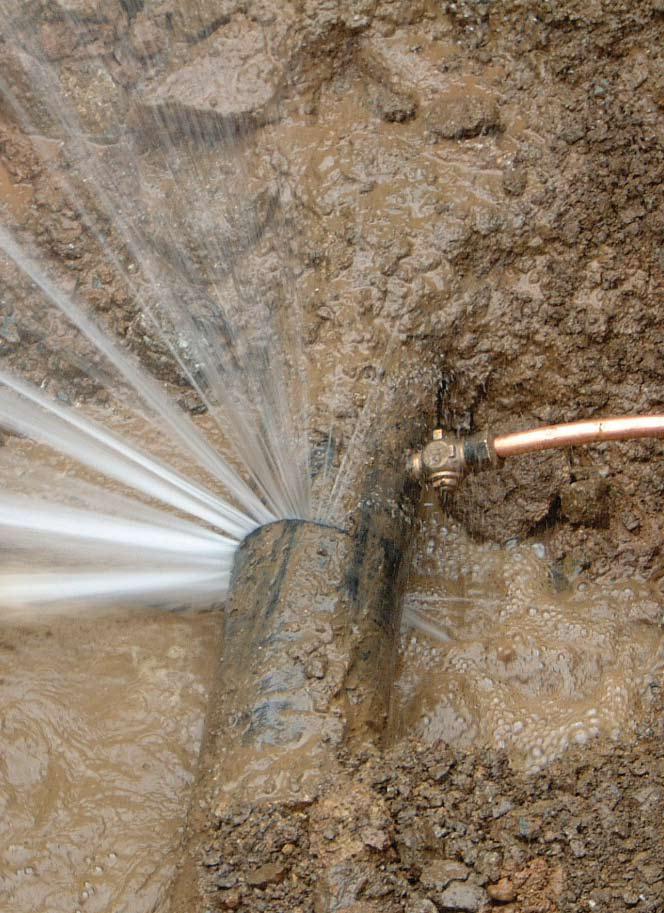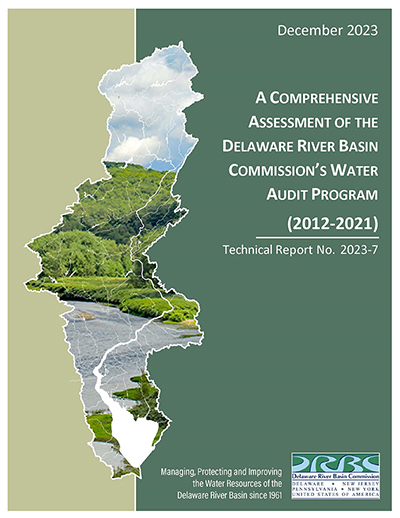Delaware • New Jersey • Pennsylvania
New York • United States of America
- Basin Water Use
- Groundwater
- Water Conservation Program
- Water Audit Program
- Data Centers
- Water Withdrawal & Consumptive Use: Estimates & Projections (2021 Report)
- Evaluation of Additional Storage in the Delaware River Basin (2023 Report)
- Water Management Advisory Committee
- Water Resource Data Sets
- Water Charging Program
- Introduction
- Dec. 2023 Publication: A Comprehensive Assessment of the DRBC's Water Audit Program (2012-2021)
- Instructions on How to Submit a Water Audit
- DRBC Presentations & Links for More Info
- DRBC's Water Audit Program Archives
 |
Did You Know?
Nationwide, roughly 6 billion gallons of treated water is lost per day, i.e., taken from water resources by public water suppliers but never reaches the customer.
As of calendar year 2024, in the Delaware River Basin, this number is estimated at 214 million gallons per day.
Water is a finite resource. As demand for water increases, it is essential to ensure that water infrastructure is dependable and able to efficiently move water from source to customer.
Delaware River Basin
The Delaware River Basin supplies drinking water to about 14.2 million people, about 4% of the U.S. population. Collectively, this number would be considered the 5th largest state in the country. Most of this population - ~85% - is likely serviced by public water supply. For the DRBC, it is critical to understand the efficiency of these public systems when assessing the sustainability and resiliency of our shared water resources.
How is Water Lost?
• Real Water Losses
• From physical infrastructure failures, e.g., leaking pipes
• It is important to note that all systems will leak; this is known as Unavoidable Annual Real Losses (UARL)
• Apparent Losses
• From inaccurate meter readings
• From erroneous billing practices
• Unbilled Authorized Consumption
• For example, from fire hydrants, sewer flushings
• While considered losses, they are authorized, and therefore not incl. in the estimated total of Basin water loss)
Water System Audits: The Old Way
In the past, audits were conducted in the absence of consistent definitions and standards. They also often used inappropriate metrics for measuring water supply efficiency.
Not surprisingly, some systems billed only half, or less, of the total water they treated, pressurized and put into the distribution system.
DRBC's Water Audit Program
In 2009, the DRBC amended its Comprehensive Plan and Water Code to implement an updated water audit approach to identify and control water loss in the Basin. The revised regulations require public water suppliers, starting in 2012, to conduct an annual water audit of their systems to help identify, track and report water losses, particularly water lost due to leaky infrastructure.
Understanding how much water is lost in distribution systems helps public water suppliers reduce water demand at the source, reduce treatment costs, increase system efficiency and reduce lost revenue.
The new proactive approach is consistent with the International Water Association (IWA) and American Water Works Association (AWWA) Water Audit Methodology that is considered a best management practice in water loss control.
The DRBC's revised rules result in a clearer understanding of the causes of water loss and allow system operators, utility managers and regulators better target their efforts to improve water supply efficiency, saving water and money.
The DRBC is one of a handful of regulatory agencies in the United States that has changed its regulations to reflect the improved approach to water loss accounting made possible by the IWA/AWWA methodology. The rule changes approved by the DRBC Commissioners in 2009 were developed by DRBC staff and the DRBC's Water Management Advisory Committee (WMAC). Additional information on the DRBC rule change can be found under DRBC's Water Audit Program Archives.
 |
Report Published December 2023
In December 2023, the DRBC published A Comprehensive Assessment of the Delaware River Basin Commission's Water Audit Program (2012-2021). The report provides a detailed look at ten years of Water Audit Program (Program) data. This analysis is the first of its kind in the country.
• View Report (pdf)
• View News Release (issued December 4, 2023)
Key Takeaways
• Drinking water is a critical use of our Basin's resources, and data on water loss is a critical component of water resource planning.
• Approximately 300 public water supply systems perform annual water audits under the DRBC Program.
• Water losses have remained relatively constant over the past ten years, although increasing trends were seen in 2020 and 2021.
• There is broad compliance with the program. Water supply systems required to submit audits have done so, highlighting strong partnerships and communication between the DRBC and the regulated community.
• Through the water audit program, the DRBC now has a foundational dataset to support its Basin-scale planning efforts. Results from the study support the Commission's ongoing water conservation goals by providing a quantitative data-based foundation to guide future practices and policies, helping ensure reliable and sustainable water supplies in the Basin.
The Water Audit requirement applies to all public water suppliers within the Delaware River Basin who have been issued approvals by the DRBC to withdraw and use in excess of an average of 100,000 gallons per day (gpd) of water during any 30-day period.
Water Audits are based on a calendar year and are due by March 31 of the following year.
To complete the DRBC water audit requirement for your system(s), please follow these steps
1. Download the AWWA Water Loss Control Committee Free Water Audit Software from the AWWA’s website at: https://www.awwa.org/Resources-Tools/Resources/Water-Loss-Control
Note that to download the Free Water Audit Software, you must either log in as an AWWA member or register (registration is free). Only Version 6.0 of the software may be used to satisfy the DRBC water audit requirement.
2. Click the link to download the software. In the dialog box that opens, choose a method to save the file to your computer. Depending on the web browser you are using, the steps for saving the software will vary. Make note of where you have saved the software on your computer before proceeding.
3. Open the software from your computer and fill out all data entry fields on the “Reporting Worksheet” tab. Enter your contact information on the “Instructions” tab. Further detailed instructions and definitions are included within the software itself.
4. In the “Comments” section of the software, enter the DRBC docket number for the system on which you are reporting. If you wish to include additional comments, please add them after entering your docket number in the “Comments” field.
5. Save your completed Water Audit Software file.
6. Compose a transmittal email to water.audit@drbc.gov, including the appropriate docket or permit number in the email subject line. Attach the completed Water Audit Software file to the email. If your docket includes more than one system, ensure all audit files are attached. NOTE: Please ensure that the software is attached in the MS Excel file format. Do not attach the file as a ".pdf" or other file type. And, please do not submit a water audit if it does not generate a “score”; the audit will be returned to you for completion.
7. Please also see the DRBC’s Water Audit FAQs (pdf).
DRBC Water Audit Presentations
-
Tapping into Leakage: Using Water Audit Data for Resilience Planning in the Delaware River Basin (pdf; given at the December 2025 North American Water Loss Conference)
- Tapping into Water Loss: Using Water Audit Data for Resilience Planning in the Delaware River Basin (pdf; given at the October 2025 PA AWWA & WWOAP Fall Conference)
- Discussion: A Comprehensive Assessment of the Delaware River Basin Commission's Water Audit Program (2012-2021) (pdf; given at the February 2024 DRBC WMAC Meeting)
- A Comprehensive Assessment of the Delaware River Basin Commission's Water Audit Program (2012-2021) (pdf; given at the October 2023 DRBC WMAC Meeting)
- Brief Update: Water Audit Trends in the Delaware River Basin (pdf; given at the June 2023 DRBC WMAC Meeting)
- DRBC Water Audit Update (pdf; given at the February 2023 DRBC WMAC Meeting)
- DRBC Water Demand Management: Benefits of Promoting Best Practices (pdf; given at the November 2018 AWRA National Conference)
- Implementation of DRBC's Water Loss Accountability Rule (pdf; given at December 2011 DRBC Meeting)
- WMAC Update: Water Accountability (pdf; given at July 2007 DRBC Meeting)
Other Helpful Links
- AWWA's Free Water Audit Software: The free Water Audit Software operates as a spreadsheet designed in Microsoft Excel format and provides an effective, standardized structure to perform a water audit consistent with DRBC’s new regulations.
- AWWA's M36 Manual (4th edition) Water Audits and Water Loss Control: This recently updated guidance manual covers the steps required to compile the water audit, how to plan and implement a loss control program, and includes case studies of small and large systems.
- DRBC's Water Management Advisory Committee
- Natural Resources Defense Council (NRDC): Cutting Our Losses - State Policies to Track and Reduce Leakage from Public Water Systems (DRBC's water audit program is included)
- U.S. EPA: Water Efficiency and Conservation Resources for Small Drinking Water Systems
2016 Information
- Analysis of CY2016 Water Audit Data from Public Water Supply Systems in the Delaware River Basin (pdf)
2014 Information
- Frequently Asked Questions (FAQs) regarding DRBC's Water Audit Reporting Requirements (pdf; updated Feb. 2014)
- Analysis of CY2014 Water Audit Data from Public Water Supply Systems in the Delaware River Basin (pdf)
2012 Information
-
DRBC CY2012 Water Audit Program Summary (pdf; presentation given at October 2013 DRBC WMAC Meeting)
-
DRBC's New Water Loss Reporting Program Helps Track Water Supply Efficiency in the Basin (March 31, 2014, DRBC News Release)
Earlier Water Audit Program Info
- Water System Audits and Water Loss Control Workshop (webpage; April 2011 - DRBC partnered with the Philadelphia Water Department, NJ American Water and Aqua Pennsylvania to present this day long workshop)
- DRBC Resolution Changes (pdf; 2009; document contains pertinent changes to DRBC’s Water Code (pdf) in reference to Water Audits and Accounting for Water Losses)
- DRBC Notice of Final Rulemaking as appears in the November 20, 2009 Federal Register (pdf; 2009)
- DRBC Response to Comments Document on Proposed Rule Change (pdf; 2008)
Copyright © Delaware River Basin Commission,
P.O. Box 7360, West Trenton, NJ 08628-0360
Phone (609)883-9500; Fax (609)883-9522
Thanks to NJ for hosting the DRBC website
